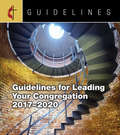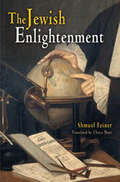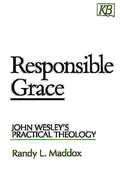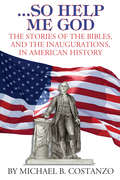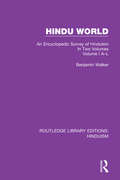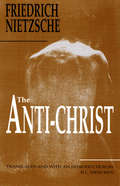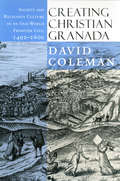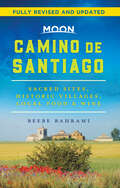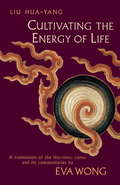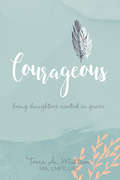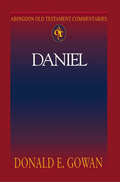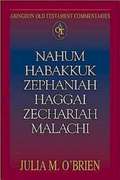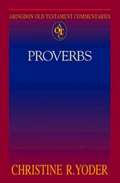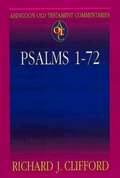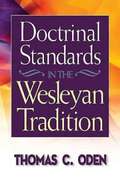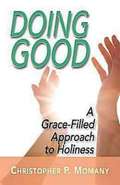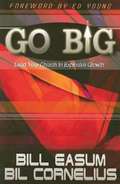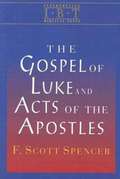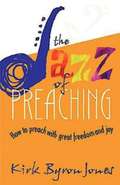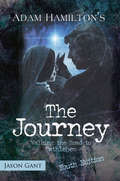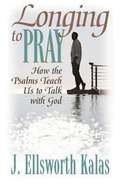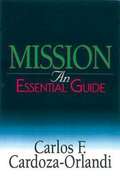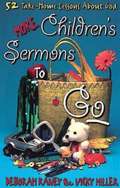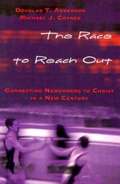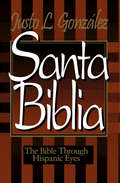- Table View
- List View
Guidelines for Leading Your Congregation 2017-2020 Complete Set with Slipcase: For Each Ministry of Your Church
by General Board Of Discipleship"The local church is to minister to persons in the community where the church is located, to provide appropriate training and nurture to all, to cooperate in ministry with other local churches, to defend God's creation and live as an ecologically responsible community, and to participate in the worldwide mission of the church." -- Book of Discipline 2012 ¶202 The twenty-six Guidelines for Leading Your Congregation, one for each ministry area, cover church leadership areas, as well as areas focused on nurture, outreach, and witness. The booklets are tools that get new lay leaders off to a good start and as a reference resource for all lay leaders. Each booklet includes the basic "job description" for the leader as well as practical "how-to" information important to implementing ministry effectively. Brief and to the point making it a perfect resource for the busy, but spirit-led leader. eBook Edition allows you download a digital file of all 26Guidelines to your eReader for personal use.
The Jewish Enlightenment
by Chaya Naor Shmuel FeinerAt the beginning of the eighteenth century most European Jews lived in restricted settlements and urban ghettos, isolated from the surrounding dominant Christian cultures not only by law but also by language, custom, and dress. By the end of the century urban, upwardly mobile Jews had shaved their beards and abandoned Yiddish in favor of the languages of the countries in which they lived. They began to participate in secular culture and they embraced rationalism and non-Jewish education as supplements to traditional Talmudic studies. The full participation of Jews in modern Europe and America would be unthinkable without the intellectual and social revolution that was the Haskalah, or Jewish Enlightenment.Unparalleled in scale and comprehensiveness, The Jewish Enlightenment reconstructs the intellectual and social revolution of the Haskalah as it gradually gathered momentum throughout the eighteenth century. Relying on a huge range of previously unexplored sources, Shmuel Feiner fully views the Haskalah as the Jewish version of the European Enlightenment and, as such, a movement that cannot be isolated from broader eighteenth-century European traditions. Critically, he views the Haskalah as a truly European phenomenon and not one simply centered in Germany. He also shows how the republic of letters in European Jewry provided an avenue of secularization for Jewish society and culture, sowing the seeds of Jewish liberalism and modern ideology and sparking the Orthodox counterreaction that culminated in a clash of cultures within the Jewish community. The Haskalah's confrontations with its opponents within Jewry constitute one of the most fascinating chapters in the history of the dramatic and traumatic encounter between the Jews and modernity.The Haskalah is one of the central topics in modern Jewish historiography. With its scope, erudition, and new analysis, The Jewish Enlightenment now provides the most comprehensive treatment of this major cultural movement.
Responsible Grace: John Wesley's Practical Theology (Kingswood Ser.)
by Randy MaddoxOf special focus in this reflective overview of Wesley's theological convictions is highlighting the practical-theological dynamics of Wesley's work and suggesting possible implications for contemporary attempts to recover theology as a practical discipline. Another distinctive focus of this work is a systematic consideration of the integration of theological emphases traditionally divergent in Eastern and Western Christianity. The author also closely examines the consistency of Wesley's thought throughout his career.
…So Help Me God: The Stories of the Bibles, and the Inaugurations, in American History
by Michael B. CostanzoThe author tells the ultimate story of the use of the Bible in the United States with a brief glance back to its first use by Charlemagne in 800 then quickly moves to the beginning of constitutional government in the United States. He tells of the inaugurations beginning with George Washington in New York in 1791 when he placed his hand on a Bible loaned by a nearby Masonic lodge. Following Washington's inauguration, the author tells the story of each Bible, where it came from, how it was secured and where it is now. The story of each inauguration is also told showing the remarkable trajectory of growth in presidential celebrations and the American culture. Presidential inaugurations in other governments, on what is now U.S. soil such as the Republic of Texas, the Confederate States of America and the Republic of Hawaii, are also told. As a prelude to the stories, the author brings into focus the various editions and printings of the Bible to meet the satisfactory demands of different perspectives. It is a complete look at the use of the Book in United States Officialdom. Since George Washington used one in his 1789 inauguration, the Bible has become an indelible part of almost every American presidential inauguration. This book is a history of known Bibles used in every American presidential inauguration. It covers the United States, as well as other governments which had one time or another occupied territories now part of the United States, such as the Confederate States of America, and the Republic of Texas.
Hindu World: An Encyclopedic Survey of Hinduism. In Two Volumes. Volume I A-L (Routledge Library Editions: Hinduism #4)
by Benjamin WalkerThis work, first published in 1968, presents the fabulous world of Hinduism in its entirety in two volumes. It is the first general encyclopedia of Hinduism covering every major aspect of Hindu life and thought, embodying the results of modern scholarship yet not ignoring the traditional point of view. It contains over 700 articles, each of which gives a comprehensive account of the subject, and by a system of cross references interlinks all topics related to it, so that a single theme may be traced in all its ramifications through the whole book. An index of over 8,000 items, which in itself forms a veritable treasury of Sanskrit terms and names, will further assist the researcher finding their way among the lesser topics treated in the work.
The Anti-Christ
by H. L. Mencken Friedrich NietzscheThis is Nietzsche's last book and a fitting capstone to his career. It's succinct, biting, and encapsulates the criticisms of Christianity found in his other works. This edition contains an 8,000-word introduction by its translator, the famous iconoclastic writer H. L. Mencken.
Creating Christian Granada
by David ColemanCreating Christian Granada provides a richly detailed examination of a critical and transitional episode in Spain's march to global empire. The city of Granada-Islam's final bastion on the Iberian peninsula-surrendered to the control of Spain's "Catholic Monarchs" Isabella and Ferdinand on January 2, 1492. Over the following century, Spanish state and Church officials, along with tens of thousands of Christian immigrant settlers, transformed the formerly Muslim city into a Christian one. With constant attention to situating the Granada case in the broader comparative contexts of the medieval reconquista tradition on the one hand and sixteenth-century Spanish imperialism in the Americas on the other, Coleman carefully charts the changes in the conquered city's social, political, religious, and physical landscapes. In the process, he sheds light on the local factors contributing to the emergence of tensions between the conquerors and Granada's formerly Muslim, "native" morisco community in the decades leading up to the crown-mandated expulsion of most of the city's moriscos in 1569-1570. Despite the failure to assimilate the moriscos, Granada's status as a frontier Christian community under construction fostered among much of the immigrant community innovative religious reform ideas and programs that shaped in direct ways a variety of church-wide reform movements in the era of the ecumenical Council of Trent (1545-1563). Coleman concludes that the process by which reforms of largely Granadan origin contributed significantly to transformations in the Church as a whole forces a reconsideration of traditional "top-down" conceptions of sixteenth-century Catholic reform.
Moon Camino de Santiago: Sacred Sites, Historic Villages, Local Food & Wine (Travel Guide)
by Beebe BahramiOver 1,200 years old, 500 miles long, and rich with tradition, history, and inspiration: Embark on the trip of a lifetime with Moon Camino de Santiago. Inside you'll find:Strategic trekking advice for walking the Camino, including where to start to get the Compostela certificate and excursions to gateway cities like Santiago, Léon, and Pamplona Unique ideas for enriching your experience: Admire folkloric art and Romanesque churches, stroll through the stone archways and winding alleys of medieval cities, and soak up mountain views as you cross over the Pyrenees and descend into green valleys. See the archaeological site where Europe's oldest humans were uncovered and breathe in the salty ocean air as you finish your journey at the shores of the Atlantic Savor the local flavors: Enjoy authentic jamón serrano, tapas, and Galician wine, or grab cheese and freshly baked bread for a picnic lunch The best detours, festivals, and villages along the way: Linger in Estella, witness the running of the bulls in Pamplona, visit the monastery in Nájera, or sip wine in Cacabelos Essential planning information on when to go, how to get there, where to eat, and where to stay, from pilgrim dorms to private hotels, plus tips on hazards, precautions, and gearExpert advice from Beebe Bahrami, who has walked the Camino more than 20 times, including valuable history and context of the pilgrimage and the sacred sites, landscape, culture, and local etiquette Full-color photos and detailed maps throughout, plus a handy fold-out map of the entire route Helpful resources on Covid and walking the Camino Handy tools and background information including Spanish and French phrasebooks, visa information, volunteer opportunities, and tips for seniors, women traveling alone, religious and secular travelers, and LGBTQ travelers Start your transformative journey with Moon Camino de Santiago&’s expert insight, unique suggestions, and practical advice. About Moon Travel Guides: Moon was founded in 1973 to empower independent, active, and conscious travel. We prioritize local businesses, outdoor recreation, and traveling strategically and sustainably. Moon Travel Guides are written by local, expert authors with great stories to tell—and they can't wait to share their favorite places with you. For more inspiration, follow @moonguides on social media.
Cultivating the Energy of Life
by Liu Hua-YangHere is the Hui-ming Ching, a classic Taoist manual on the circulation of internal energy by means of meditation and the inspiration for many techniques of Qigong. It is one of the few Taoist treatises to describe the landmarks of spiritual development and document the process of spiritual transformation from start to finish.
Courageous: Being Daughters Rooted in Grace
by Terra A. MattsonThe stakes have never been higher as daughters of every age are navigating a world of hyper-sexualization, social media hangover, extreme loneliness, and a flood of confusing messages. Whether readers desire to know more of who they are created to be or are raising daughters who are just beginning their own journeys, Courageous leads women and those they love through transformation as they experience: confidence in who God made them to be resiliency regardless of circumstances faithfulness to God's heartbeatbold living through faith-filled risk-taking the joy of finding their voice and then using it for the voicelessvibrant community with other daughters Crafted with biblical wisdom, professional insights, and personal stories, Courageous explores the core concerns that plague every woman's relationship with God, self, and others. Terra Mattson invites women and girls to join a global movement of Courageous Girls as they discover an empowered sense of purpose and an identity rooted in God's grace so they can love and be loved like never before. Exploring issues such as the comparison game, body image, sexuality, and friendships, Courageous is for any woman investing in the next generation of girls. The stakes have never been higher to nurture the daughter in every woman to be confident in who she is, emboldened to use her voice for world change, and deepen her roots in grace.
Abingdon Old Testament Commentaries | Daniel (Abingdon Old Testament Commentaries)
by Donald E. GowanThe Abingdon Old Testament Commentaries series offers compact, critical commentaries on all the books of the Old Testament. In addition to providing fundamental information on and insights into Old Testament writings, these commentaries exemplify the tasks and procedures of careful, critical exegesis so as to assist students of the Old Testament in coming to an informed engagement of the biblical texts themselves. These commentaries are written with special attention to the needs and interests of theology students, but they will also be useful for students in upper-level college or university settings, as well as for pastors and other church leaders. Each volume consists of four parts: -- an introduction that addresses the key issues raised by the writing; the literary genre, structure, and character of the writing; the occasional and situational context of the writing, including its wider social and historical context; and the theological and ethical significance of the writing within these several contexts -- a commentary on the text, organized by literary units, covering literary analysis, exegetical analysis, and theological and ethical analysis -- an annotated bibliography -- a brief subject index Gowan takes full account of the most important current scholarship and secondary literature, while not attempting to engage in technical academic debate. The fundamental concern of this and every volume is analysis and discussion of the literary, sociohistorical, theological, and ethical dimensions of the biblical texts themselves. Each volume attends to issues of special concern to students of the Bible: literary genre, structure and character of the writing, occasion and situational context of the writing, wider social and historical context, the theological and ethical significance of the writing within these several contexts, and the like. Daniel--one of the most misused books of the Bible--is read in this commentary as a powerful message concerning hope and responsibility for believers who, for various reasons, have to face the theological question, "Who's in charge here?" The book of Daniel insists that the God of Israel is in charge, in spite of what circumstances may indicate; then finds ways, through story and vision, to reassure the faithful that there is a future for them after all. The commentary shows that what might be taken as just "Sunday school stories"--the lions' den and the fiery furnace--do raise issues from real life that have faced believers time and again across the centuries. It also helps readers to understand how to read Daniel's predictions of the future in a way that is most faithful to Scripture as a whole. The author explores the widely disparate meanings that have been attributed to the visions in the book. He investigates four basic interpretations that form the basis of reading the Book of Daniel.
Abingdon Old Testament Commentaries | Nahum, Habakkuk, Zephaniah, Haggai, Zechariah, Malachi (Abingdon Old Testament Commentaries)
by Julia M. O'BrienThe Abingdon Old Testament Commentaries provide compact, critical commentaries on the books of the Old Testament for the use of theological students and pastors. The commentaries are also useful for upper-level college or university students and for those responsible for teaching in congregational settings. In addition to providing basic information and insights into the Old Testament writings, these commentaries exemplify the tasks and procedures of careful interpretation, all to assist students of the Old Testament in coming to an informed and critical engagement with the biblical texts themselves. The six books found at the close of the Minor Prophets (Nahum, Habakkuk, Zephaniah, Haggai, Zechariah, and Malachi) present distinctive understandings of God, humanity, and the future. This commentary engages those understandings, considers what the books may have meant in the past, and describes how they resonate with contemporary readers. With attention to issues of gender, violence, and inclusivity, O'Brien explores the ethical challenges of the books and asks how faithful readers can both acknowledge the problems these biblical books raise and appreciate their value for contemporary theological reflection.
Abingdon Old Testament Commentaries | Proverbs: Abingdon Old Testament Commentaries (Abingdon Old Testament Commentaries)
by Patrick D. Miller Christine R. YoderProverbs shape our moral imagination.The Abingdon Old Testament Commentaries provide compact, critical commentaries on the books of the Old Testament for the use of theological students and pastors. The commentaries are also useful for upper-level college or university students and for those responsible for teaching in congregational settings. In addition to providing basic information and insights into the Old Testament writings, these commentaries exemplify the tasks and procedures of careful interpretation, to assist students of the Old Testament in coming to an informed and critical engagement with the biblical texts themselves.The book of Proverbs invites us into an ancient and ongoing conversation about what is good and wise and true in life. Yoder explores the book through literary, exegetical, and theological-ethical analysis, paying particular attention to how Proverbs shapes the moral imagination of its readers. She highlights the poetics of each proverb, considers similarities and differences between the book's sections, and ponders how the content, pedagogies, and arrangement of Proverbs contribute to its aim to form "fearers of the Lord."
Abingdon Old Testament Commentaries | Psalms 1-72: Psalms 1-72 (Abingdon Old Testament Commentaries #Vol. 22)
by Richard J. CliffordClifford differs from other commentators on the Psalms chiefly in his concern with the inner dramatic logic of the Psalms - how they organize the experience and desires of the "pray-er" and bring them to a proper conclusion. His primary concern is to help readers see the pattern and progression within the Psalms, while at the same time attending to the richness of their words and the texture of their imagery.
Doctrinal Standards in the Wesleyan Tradition: Revised Edition
by Thomas C. OdenThe history of Wesleyan family of churches doctrines What are our core beliefs? Doctrinal Standards in the Wesleyan Tradition, Revised Edition, narrates the history of the formation of Wesleyan doctrines, describing how they were transplanted from the British Isles to North American, how they became constitutionally protected in Wesleyan-rooted churches. The first edition of this book affected the outcome of the 1988 General Conference of The United Methodist Church as the delegates decided many then-disputed doctrinal issues. This revised edition addresses the continuing hunger for more precise and useful information on the doctrinal traditions of mainline Protestantism. Hence the arguments have been updated with more than 400 changes. Included are doctrinal statements for the Evangelical United Bethren, Free Methodist, Methodist Protestant, Wesleyan, Nazarene, African Methodist Episcopal Zion, Christian Methodist Episcopal, and African Methodist Episcopal Churches; as well as an outline syllabus of a Course on the Articles of Religion.
Doing Good: A Grace-Filled Approach to Holiness
by Christopher P. MomanyChristianity in its purest form involves putting God's love into action. Wesleyans have traditionally understood this embodiment and expression of God's love as holiness. * Four-session guide helps individuals and small groups understand and embrace the Wesleyan understanding of holiness * Explores the Wesleyan approach to both law and grace * Guides individuals to match faith with action * Provides Christian educators with a tool for teaching an important Wesleyan doctrine * Shows individuals and churches how to express Christianity in ways that attract others to the faith and the life of the church
Go BIG: Lead Your Church to Explosive Growth
by William M. Easum Bil CorneliusBill Easum and Bil Cornelius are two strikingly different, yet surprisingly similar pastors. One undertook to revitalize a moribund mainline church; the other, to plant a new nondenominational congregation. Coming from different generations, their ministries took place under dissimilar circumstances. Yet both have experienced substantial, even explosive, growth in congregational mission and membership. Along the way they learned some important lessons, such as the centrality of strong pastoral leadership, the need for an unhesitating pursuit of excellence in all areas of the church's ministry, and the requirement that you picture an audacious vision for your church and live into that vision. Regardless of the current size of your church, you will find here inspiring, ready-to-implement ideas to help your church go BIG.
The Gospel of Luke and Acts of the Apostles: Interpreting Biblical Texts Series (Interpreting Biblical Texts)
by F. Scott SpencerIntroduces literary, historical, and theological issues of Luke and Acts. Biblical texts create worlds of meaning, and invite readers to enter them. When readers enter such textual worlds, which are often strange and complex, they are confronted with theological claims. With this in mind, the purpose of the Interpreting Biblical Texts series is to help serious readers in their experience of reading and interpreting by providing guides for their journeys into textual worlds. The controlling perspective is expressed in the operative word of the title--interpreting. The primary focus of the series is not so much on the world behind the texts or out of which the texts have arisen as on the worlds created by the texts in their engagement with readers. In keeping with the goals of the series, this volume provides an introductory guide to readers of the New Testament books of Luke and Acts. It focuses on both the synchronic and diachronic dimensions of the literature in an effort to acquaint readers with literary, historical, and theological issues that will facilitate interpretation of these important books. F. Scott Spencer is Professor of New Testament at Baptist Theological Seminary at Richmond.
The Jazz of Preaching: How to Preach with Great Freedom and Joy
by Kirk Byron JonesWhat if preachers were as contagiously joyful in their preaching as Louis Armstrong was in his playing and singing? As rich in their sermonic renderings as Sarah Vaughan was in her musical vocals? As honest about heartache as Billie Holiday was every time she sang about the blues of life? As alluringly clear as the angelic voice of Ella Fitzgerald? As tenaciously uninhibited in the action of creating as Duke Ellington? Of course, this is too much to ask of people, even those called by God. However, it is not too much to ask this question: Can preaching be enhanced through the metaphor of jazz? Can an understanding of the inner dynamics of jazz--its particular forms, rules, and styles--inform one's practice of preaching as well? Can jazz's simultaneous structure and spontaneity help preachers better understand their own art? The answer to these questions, says Jones, is an unqualified yes. He explains how one can dramatically improve one's preaching through understanding and applying key elements of the musical art form known as jazz. No musical background is necessary; all examples are well explained and tied in with preaching. The key elements include innovation (what one commentator refers to as "the experimental disposition of jazz"), improvisation, rhythm, call and response, honesty about heartaches, and delight. After discussing the reality and role of each of these elements in jazz, and how they can be important for preaching as well, each chapter concludes with five exercises for applying the jazz element to preaching preparation and performance. Drawing on a deep love of jazz and enlivening the discussion with insights drawn from the realities of African American preaching, Jones introduces readers to rich and rewarding possibilities for constructing and delivering the sermon.
The Journey for Youth: Walking the Road to Bethlehem (The Journey)
by Adam Hamilton Jason GantIt's a captivating story--one that has been told many times before, but never quite this way. Popular pastor, author, and speaker Adam Hamilton guides teens on a journey to experience the anxiety and anticipation that Joseph and Mary felt as they prepared for the birth of Jesus. Youth will meet familiar characters, including Elizabeth, Mary's older relative; the lowly night-shift shepherds who were the first to hear the good news of the Savior's birth; and many others. They will spend time in the towns surrounding the Holy Land and will travel with Mary and Joseph on that unforgettable journey from Nazareth to Bethlehem, where Jesus was born. This is a journey that is meant to be shared. Take your first step now. This five-week resource for youth includes leader helps. You will need one copy for every participant as well as your leader. It also provides resources for incorporating The Journey: DVD with Leader Guide and doing a book study of Adam Hamilton's The Journey: Walking the Road to Bethlehem.
Longing to Pray: How the Psalms Teach Us to Talk with God
by J. Ellsworth KalasFrom the Foreword - This little book invites us to study with some ancient experts in prayer, the persons who wrote the Book of Psalms. We haven't read long in the psalms before we realize that the authors were altogether human, with a massive catalog of troubles, inconsistencies, and questions. Their lives were marked by breathtaking highs and lows, with sometimes only a few paragraphs between. But with all of that, they were saints. They left us with the greatest collection of prayers in the possession of our human race. What was their secret? I believe it was the quality of their friendship with God. And of course the language of that friendship is prayer. The psalmists don't give us any formula for effective praying. They don't offer a set of rules. But if we read their prayers carefully, we will learn something of their secret, the secret of the Ultimate Friendship. I hope through this book to start us on that special journey. ---- J. Ellsworth Kalas The book will contain a disussion guide by John Schroeder
Mission: An Essential Guide (Essential Guides Ser.)
by Carlos Cardoza-Orlandi"Mission" has become, for many North American Christians, an ambiguous and often uncomfortable term. To many it brings to mind a past in which western culture was identified with the gospel in missionary practice and programs. Distressed with this history and uncertain about how to overcome it, many prefer to ignore the New Testament mandate that the church must be in mission if it is to be the church. Others swing the other way, declaring that everything the church does is mission, depriving the idea of mission of its power to define those specific actions of God which proclaim the gospel and build God's kingdom. "The church exists by missions, just as fire exists by burning." With these words of Emil Brunner, the author reminds us that to be the church is to be in mission. After describing the various "captivities of mission" which plague North American Christianity, the author argues for a robust and engaged practice of mission, beginning in congregations and extending to the broader community.
More Children's Sermons To Go: 52 Take-Home Lessons About God
by Deborah RaneyMore Children's Sermons to Go: 52 Take-Home Lessons About God offers a year's worth of children's sermons that feature small, inexpensive gifts or trinkets that help children better understand and remember the lesson of the sermon. Each of the sermon lessons in More Children's Sermons to Go includes a Materials section, a selected Scripture text, and a take-home memento of the sermon lesson. These mementos are quick, inexpensive ideas that require 30 minutes or less of preparation time.
The Race to Reach Out: Connecting Newcomers to Christ in a New Century
by Doug Anderson Michael J. CoynerMost church members would tell you that theirs is a friendly congregation, eager to welcome visitors and new members into their midst. Yet far too many of these same congregations have trouble translating this intention into action. Offering a friendly greeting to a new face is important, but it is only the first of many steps that congregations must take in order to turn visitors into members, and new members into committed disciples. The authors believe that to assimilate newcomers into the life and ministry of the congregation, the whole church system must be involved. Anderson and Coyner demonstrate how to identify and respond to visitors in a nonthreatening, yet interested way; how to share information about them with the leaders of those ministries and programs in which they would be most interested; how best to help them in their decision to become church members; and how to help them understand and fulfill their own call to ministry in the congregation. They insist that churches be motivated, not by a desire for institutional survival or advancement, but by a passion for people and their place in the kingdom of God.
Santa Biblia: The Bible Through Hispanic Eyes
by Justo L. GonzálezGonzalez explores how a Hispanic perspective illuminates the biblical text in ways that will be valuable not only for Latino readers but also for the church at large. Introducing five "paradigms" for Latino biblical interpretation, Gonzalez discusses theory and provides concrete examples of biblical texts that gain new meaning when read from a different perspective.
